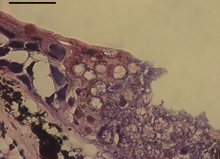| Batrachochytrium salamandrivorans | |
|---|---|

| |
| Bsal infection in the skin of a fire salamander | |
| Scientific classification | |
| Domain: | Eukaryota |
| Kingdom: | Fungi |
| Division: | Chytridiomycota |
| Class: | Chytridiomycetes |
| Order: | Rhizophydiales |
| Family: | Batrachochytriaceae |
| Genus: | Batrachochytrium |
| Species: | B. salamandrivorans
|
| Binomial name | |
| Batrachochytrium salamandrivorans Martel A., Blooi M., Bossuyt F., Pasmans F. (2013)[1]
| |
Batrachochytrium salamandrivorans (Bsal) is a pathogenic chytrid fungus that infects amphibian species. Although salamanders and newts seem to be the most susceptible, some anuran species are also affected. Bsal has emerged recently and poses a major threat to species in Europe and North America.
It was described in 2013 based on a strain collected from skin tissue of fire salamanders Salamandra salamandra. The pathogen, unidentified up to then, had devastated fire salamander populations in the Netherlands. Molecular phylogenetics confirmed it as related to the well known chytrid B. dendrobatidis. Like this species, it causes chytridiomycosis, which is manifested in skin lesions and is lethal for the salamanders.[1] Damage to the epidermal layer can be extensive and may result in osmoregulatory[2] issues or sepsis.[3]

Another study estimated that this species had diverged from B. dendrobatidis in the Late Cretaceous or early Paleogene. While initial susceptibility testing showed frogs and caecilians seemed to be resistant to Bsal infection, it was lethal to many European and some North American salamanders. East Asian salamanders were susceptible but able to tolerate infections. The fungus was also detected in a more-than-150-year-old museum specimen of the Japanese sword-tailed newt. This suggests it had originally emerged and co-evolved with salamanders in East Asia, forming its natural reservoir, and was introduced to Europe rather recently through the trade of species such as the fire belly newts as pets.[4] The asian origin hypothesis for Bsal is supported by additional studies which have found Bsal in wild urodela populations in Asia and in animals of asian origin being transported via the pet trade.[5][6][7] Since the pathogens initial discovery, it has been found in several additional areas across Europe in both wild and captive populations. One study was able to detect Bsal in 7 of 11 captive urodele collections.[8]
The description of this pathogen and its aggressiveness raised concern in the scientific community and the public, fearing that it might be a rising threat to Western hemisphere salamanders.[9][10] On January 12, 2016, the U.S. government issued a directive that prohibited the importation of salamanders in order to reduce the threat posed by B. salamandrivorans.[11]
- ^ a b Cite error: The named reference
Martel2013was invoked but never defined (see the help page). - ^ Cite error: The named reference
VoylesYoung2009was invoked but never defined (see the help page). - ^ Cite error: The named reference
BletzKelly2018was invoked but never defined (see the help page). - ^ Cite error: The named reference
MartelBlooi2014was invoked but never defined (see the help page). - ^ Cite error: The named reference
CunninghamBeckmann2015was invoked but never defined (see the help page). - ^ Cite error: The named reference
LakingNgo2017was invoked but never defined (see the help page). - ^ Cite error: The named reference
NguyenNguyen2017was invoked but never defined (see the help page). - ^ Cite error: The named reference
FitzpatrickPasmans2018was invoked but never defined (see the help page). - ^ Cite error: The named reference
Stokstad2014was invoked but never defined (see the help page). - ^ Cite error: The named reference
TechTimeswas invoked but never defined (see the help page). - ^ "Listing Salamanders as Injurious Due to Risk of Salamander Chytrid Fungus". U.S. Fish and Wildlife Service. January 12, 2016.